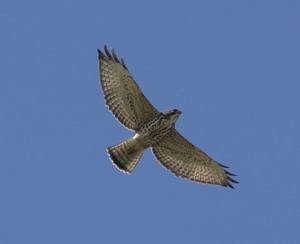Accurate knowledge of population trends is fundamental to wildlife conservation, but reliable information is lacking for many raptor species. Counts of migrating raptors may be the key to filling these gaps.
What are Raptors?

A Broad-winged Hawk soars past the Pack Monadnock Raptor Observatory. (photo © Katrina Fenton)
Diurnal (or day-active) raptors are sometimes referred to simply as “hawks.” However, in addition to hawks, this group also includes eagles, falcons, ospreys, vultures, kites, and harriers, with species ranging in size from the diminutive American Kestrel — not much bigger than a robin — to the massive Bald Eagle, whose wingspan exceeds six feet. Each fall, we regularly observe up to 15 different raptor species at the Pack Monadnock Raptor Observatory.
Why Study Raptors?
Raptors are particularly good indicators of environmental health because they inhabit most ecosystem types, occupy large home ranges, feed at the top of the food web, and are highly sensitive to chemical contamination and other human disturbance. They are also easy to tally when they congregate during migration along coastlines, prominent mountain ridges, and river valleys.
What Have We Learned?
The Pack Monadnock Raptor Observatory is part of a network of more than 300 raptor migration monitoring sites throughout the United States, Canada, and Central America. Together, the standardized, long-term data collected at these sites can provide important information on raptor migration patterns and behavior, as well as the potential impacts of climate change and other stressors on raptor populations.
Our data have already demonstrated healthy rebounds in Bald Eagle and Peregrine Falcon populations, which were once in decline due to the use of DDT. We have also recorded population declines in the American Kestrel and Northern Harrier, signaling the need for local and regional conservation actions on behalf of these species.
Contact Us
For more information on the Pack Monadnock Raptor Observatory or to volunteer, please contact Bird Conservation Director Phil Brown.

